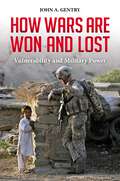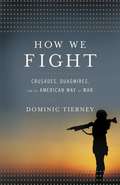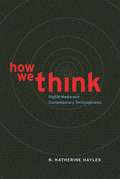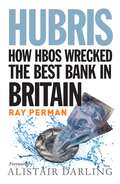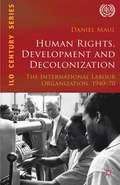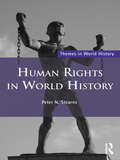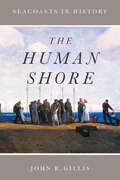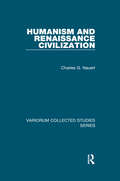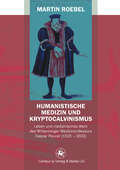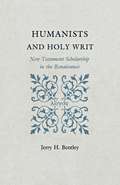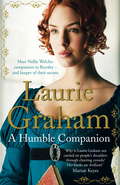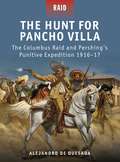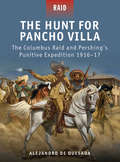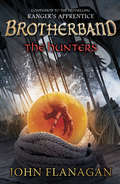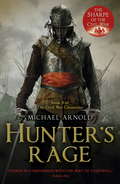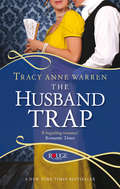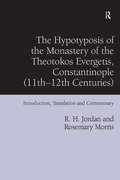- Table View
- List View
How Wars Are Won and Lost: Vulnerability and Military Power (Praeger Security International)
by John A. GentryThis provocative book seeks to answer a most crucial—and embarrassing—question concerning the U.S. military: why the United States is so often stymied in military confrontations with seemingly weaker opponents, despite its "superpower" status.This fascinating book examines a question that continues to puzzle soldiers, statesmen, and scholars: why do major powers—including the ostensible superpower United States—repeatedly perform poorly against seemingly overmatched adversaries? And what can they, and the United States, do to better achieve their military objectives?How Wars are Won and Lost: Vulnerability and Military Power argues that beyond relying solely on overwhelming military might, the United States needs to focus more on exploiting weaknesses in their adversaries—such as national will, resource mobilization, and strategic miscues—just as opposing forces have done to gain advantage over our military efforts. The author tests the "vulnerability theory" by revisiting six conflicts from the Philippine War of 1899-1902 to the ongoing actions in Iraq and Afghanistan, showing again and again that victory often depends more on outthinking the enemy than outmuscling them.
How We Fight: Crusades, Quagmires, and the American Way of War
by Dominic TierneyAmericans love war. We've never run from a fight. Our triumphs from the American Revolution to World War II define who we are as a nation and a people. Americans hate war. Our leaders rush us into conflicts without knowing the facts or understanding the consequences. Korea, Vietnam, and now Iraq and Afghanistan define who we are as a nation and a people. How We Fight explores the extraordinary doublemindedness with which Americans approach war, and reveals the opposing mindsets that have governed our responses throughout history: the "crusade" tradition-our grand quests to defend democratic values and overthrow tyrants; and the "quagmire" tradition-our resistance to the work of nation-building and its inevitable cost in dollars and American lives. How can one nation be so split? Studying conflicts from the Civil War to the present, Dominic Tierney has created a secret history of American foreign policy and a frank and insightful look at how Americans respond to the ultimate challenge. And he shows how success is possible. His innovative model for tackling the challenges of modern war can mean longstanding victory in Iraq and Afghanistan, by rediscovering a lost American warrior tradition.
How We Think: Digital Media and Contemporary Technogenesis
by N. Katherine Hayles“How do we think?” N. Katherine Hayles poses this question at the beginning of this bracing exploration of the idea that we think through, with, and alongside media. As the age of print passes and new technologies appear every day, this proposition has become far more complicated, particularly for the traditionally print-based disciplines in the humanities and qualitative social sciences. With a rift growing between digital scholarship and its print-based counterpart, Hayles argues for contemporary technogenesis—the belief that humans and technics are coevolving—and advocates for what she calls comparative media studies, a new approach to locating digital work within print traditions and vice versa. Hayles examines the evolution of the field from the traditional humanities and how the digital humanities are changing academic scholarship, research, teaching, and publication. She goes on to depict the neurological consequences of working in digital media, where skimming and scanning, or “hyper reading,” and analysis through machine algorithms are forms of reading as valid as close reading once was. Hayles contends that we must recognize all three types of reading and understand the limitations and possibilities of each. In addition to illustrating what a comparative media perspective entails, Hayles explores the technogenesis spiral in its full complexity. She considers the effects of early databases such as telegraph code books and confronts our changing perceptions of time and space in the digital age, illustrating this through three innovative digital productions—Steve Tomasula’s electronic novel, TOC; Steven Hall’s The Raw Shark Texts; and Mark Z. Danielewski’s Only Revolutions. Deepening our understanding of the extraordinary transformative powers digital technologies have placed in the hands of humanists, How We Think presents a cogent rationale for tackling the challenges facing the humanities today.
How We Think: Digital Media and Contemporary Technogenesis
by N. Katherine Hayles“How do we think?” N. Katherine Hayles poses this question at the beginning of this bracing exploration of the idea that we think through, with, and alongside media. As the age of print passes and new technologies appear every day, this proposition has become far more complicated, particularly for the traditionally print-based disciplines in the humanities and qualitative social sciences. With a rift growing between digital scholarship and its print-based counterpart, Hayles argues for contemporary technogenesis—the belief that humans and technics are coevolving—and advocates for what she calls comparative media studies, a new approach to locating digital work within print traditions and vice versa. Hayles examines the evolution of the field from the traditional humanities and how the digital humanities are changing academic scholarship, research, teaching, and publication. She goes on to depict the neurological consequences of working in digital media, where skimming and scanning, or “hyper reading,” and analysis through machine algorithms are forms of reading as valid as close reading once was. Hayles contends that we must recognize all three types of reading and understand the limitations and possibilities of each. In addition to illustrating what a comparative media perspective entails, Hayles explores the technogenesis spiral in its full complexity. She considers the effects of early databases such as telegraph code books and confronts our changing perceptions of time and space in the digital age, illustrating this through three innovative digital productions—Steve Tomasula’s electronic novel, TOC; Steven Hall’s The Raw Shark Texts; and Mark Z. Danielewski’s Only Revolutions. Deepening our understanding of the extraordinary transformative powers digital technologies have placed in the hands of humanists, How We Think presents a cogent rationale for tackling the challenges facing the humanities today.
Hubris: How HBOS Wrecked the Best Bank in Britain
by Ray Perman Alistair DarlingIn 1995 Bank of Scotland celebrated 300 years as Britain's oldest commercial bank. Voted 'most admired bank', respected by competitors, applauded by investors and trusted by customers, it looked forward to the next three hundred. Less than 15 years later it was bust, reviled as part of the spectacular collapse of HBOS, the conglomerate it had joined. One of the high-profile victims of the credit crunch, its spectacular fall caused seismic shock waves throughout the financial world. What went wrong? Ray Perman, who has followed the Bank since the 1970s when he was a Financial Times journalist, uncovered the story from documents and dozens of interviews with people at the top in Bank of Scotland and HBOS - from being the bank of choice for the highrolling Monte Carlo mega-rich to losing GBP10 billion. It is a cautionary tale for our times. In the complex world of modern global finance, the brilliant men who ran the company ignored the simple banking rules that their predecessors learned the hard way three centuries before.
Human Rights, Development and Decolonization: The International Labour Organization, 1940-70 (International Labour Organization (ILO) Century Series)
by D. MaulAn innovative diplomatic and intellectual history of decolonization, post-colonial nation building and international human rights and development discourses, this study of the role of the ILO during 1940–70 opens up new perspectives on the significance of international organisations as actors in the history of the 20th century.
Human Rights in World History (Themes in World History)
by Peter N. StearnsDefended by a host of passionate advocates and organizations, certain standard human rights have come to represent a quintessential component of global citizenship. There are, however, a number of societies who dissent from this orthodoxy, either in general or on particular issues, on the basis of political necessity, cultural tradition, or group interest. Human Rights in World History takes a global historical perspective to examine the emergence of this dilemma and its constituent concepts. Beginning with premodern features compatible with a human rights approach, including religious doctrines and natural rights ideas, it goes on to describe the rise of the first modern-style human rights statements, associated with the Enlightenment and contemporary antislavery and revolutionary fervor. Along the way, it explores ongoing contrasts in the liberal approach, between sincere commitments to human rights and a recurrent sense that certain types of people had to be denied common rights because of their perceived backwardness and need to be "civilized". These contrasts find clear echo in later years with the contradictions between the pursuit of human rights goals and the spread of Western imperialism. By the second half of the 20th century, human rights frameworks had become absorbed into key global institutions and conventions, and their arguments had expanded to embrace multiple new causes. In today’s postcolonial world, and with the rise of more powerful regional governments, the tension between universal human rights arguments and local opposition or backlash is more clearly delineated than ever but no closer to satisfactory resolution.
Human Rights in World History (Themes in World History)
by Peter N. StearnsDefended by a host of passionate advocates and organizations, certain standard human rights have come to represent a quintessential component of global citizenship. There are, however, a number of societies who dissent from this orthodoxy, either in general or on particular issues, on the basis of political necessity, cultural tradition, or group interest. Human Rights in World History takes a global historical perspective to examine the emergence of this dilemma and its constituent concepts. Beginning with premodern features compatible with a human rights approach, including religious doctrines and natural rights ideas, it goes on to describe the rise of the first modern-style human rights statements, associated with the Enlightenment and contemporary antislavery and revolutionary fervor. Along the way, it explores ongoing contrasts in the liberal approach, between sincere commitments to human rights and a recurrent sense that certain types of people had to be denied common rights because of their perceived backwardness and need to be "civilized". These contrasts find clear echo in later years with the contradictions between the pursuit of human rights goals and the spread of Western imperialism. By the second half of the 20th century, human rights frameworks had become absorbed into key global institutions and conventions, and their arguments had expanded to embrace multiple new causes. In today’s postcolonial world, and with the rise of more powerful regional governments, the tension between universal human rights arguments and local opposition or backlash is more clearly delineated than ever but no closer to satisfactory resolution.
The Human Shore: Seacoasts in History
by John R. GillisSince before recorded history, people have congregated near water. But as growing populations around the globe continue to flow toward the coasts on an unprecedented scale and climate change raises water levels, our relationship to the sea has begun to take on new and potentially catastrophic dimensions. The latest generation of coastal dwellers lives largely in ignorance of the history of those who came before them, the natural environment, and the need to live sustainably on the world’s shores. Humanity has forgotten how to live with the oceans. In The Human Shore, a magisterial account of 100,000 years of seaside civilization, John R. Gillis recovers the coastal experience from its origins among the people who dwelled along the African shore to the bustle and glitz of today’s megacities and beach resorts. He takes readers from discussion of the possible coastal location of the Garden of Eden to the ancient communities that have existed along beaches, bays, and bayous since the beginning of human society to the crucial role played by coasts during the age of discovery and empire. An account of the mass movement of whole populations to the coasts in the last half-century brings the story of coastal life into the present. Along the way, Gillis addresses humankind’s changing relationship to the sea from an environmental perspective, laying out the history of the making and remaking of coastal landscapes—the creation of ports, the draining of wetlands, the introduction and extinction of marine animals, and the invention of the beach—while giving us a global understanding of our relationship to the water. Learned and deeply personal, The Human Shore is more than a history: it is the story of a space that has been central to the attitudes, plans, and existence of those who live and dream at land’s end.
The Human Shore: Seacoasts in History
by John R. GillisSince before recorded history, people have congregated near water. But as growing populations around the globe continue to flow toward the coasts on an unprecedented scale and climate change raises water levels, our relationship to the sea has begun to take on new and potentially catastrophic dimensions. The latest generation of coastal dwellers lives largely in ignorance of the history of those who came before them, the natural environment, and the need to live sustainably on the world’s shores. Humanity has forgotten how to live with the oceans. In The Human Shore, a magisterial account of 100,000 years of seaside civilization, John R. Gillis recovers the coastal experience from its origins among the people who dwelled along the African shore to the bustle and glitz of today’s megacities and beach resorts. He takes readers from discussion of the possible coastal location of the Garden of Eden to the ancient communities that have existed along beaches, bays, and bayous since the beginning of human society to the crucial role played by coasts during the age of discovery and empire. An account of the mass movement of whole populations to the coasts in the last half-century brings the story of coastal life into the present. Along the way, Gillis addresses humankind’s changing relationship to the sea from an environmental perspective, laying out the history of the making and remaking of coastal landscapes—the creation of ports, the draining of wetlands, the introduction and extinction of marine animals, and the invention of the beach—while giving us a global understanding of our relationship to the water. Learned and deeply personal, The Human Shore is more than a history: it is the story of a space that has been central to the attitudes, plans, and existence of those who live and dream at land’s end.
The Human Shore: Seacoasts in History
by John R. GillisSince before recorded history, people have congregated near water. But as growing populations around the globe continue to flow toward the coasts on an unprecedented scale and climate change raises water levels, our relationship to the sea has begun to take on new and potentially catastrophic dimensions. The latest generation of coastal dwellers lives largely in ignorance of the history of those who came before them, the natural environment, and the need to live sustainably on the world’s shores. Humanity has forgotten how to live with the oceans. In The Human Shore, a magisterial account of 100,000 years of seaside civilization, John R. Gillis recovers the coastal experience from its origins among the people who dwelled along the African shore to the bustle and glitz of today’s megacities and beach resorts. He takes readers from discussion of the possible coastal location of the Garden of Eden to the ancient communities that have existed along beaches, bays, and bayous since the beginning of human society to the crucial role played by coasts during the age of discovery and empire. An account of the mass movement of whole populations to the coasts in the last half-century brings the story of coastal life into the present. Along the way, Gillis addresses humankind’s changing relationship to the sea from an environmental perspective, laying out the history of the making and remaking of coastal landscapes—the creation of ports, the draining of wetlands, the introduction and extinction of marine animals, and the invention of the beach—while giving us a global understanding of our relationship to the water. Learned and deeply personal, The Human Shore is more than a history: it is the story of a space that has been central to the attitudes, plans, and existence of those who live and dream at land’s end.
The Human Shore: Seacoasts in History
by John R. GillisSince before recorded history, people have congregated near water. But as growing populations around the globe continue to flow toward the coasts on an unprecedented scale and climate change raises water levels, our relationship to the sea has begun to take on new and potentially catastrophic dimensions. The latest generation of coastal dwellers lives largely in ignorance of the history of those who came before them, the natural environment, and the need to live sustainably on the world’s shores. Humanity has forgotten how to live with the oceans. In The Human Shore, a magisterial account of 100,000 years of seaside civilization, John R. Gillis recovers the coastal experience from its origins among the people who dwelled along the African shore to the bustle and glitz of today’s megacities and beach resorts. He takes readers from discussion of the possible coastal location of the Garden of Eden to the ancient communities that have existed along beaches, bays, and bayous since the beginning of human society to the crucial role played by coasts during the age of discovery and empire. An account of the mass movement of whole populations to the coasts in the last half-century brings the story of coastal life into the present. Along the way, Gillis addresses humankind’s changing relationship to the sea from an environmental perspective, laying out the history of the making and remaking of coastal landscapes—the creation of ports, the draining of wetlands, the introduction and extinction of marine animals, and the invention of the beach—while giving us a global understanding of our relationship to the water. Learned and deeply personal, The Human Shore is more than a history: it is the story of a space that has been central to the attitudes, plans, and existence of those who live and dream at land’s end.
The Human Shore: Seacoasts in History
by John R. GillisSince before recorded history, people have congregated near water. But as growing populations around the globe continue to flow toward the coasts on an unprecedented scale and climate change raises water levels, our relationship to the sea has begun to take on new and potentially catastrophic dimensions. The latest generation of coastal dwellers lives largely in ignorance of the history of those who came before them, the natural environment, and the need to live sustainably on the world’s shores. Humanity has forgotten how to live with the oceans. In The Human Shore, a magisterial account of 100,000 years of seaside civilization, John R. Gillis recovers the coastal experience from its origins among the people who dwelled along the African shore to the bustle and glitz of today’s megacities and beach resorts. He takes readers from discussion of the possible coastal location of the Garden of Eden to the ancient communities that have existed along beaches, bays, and bayous since the beginning of human society to the crucial role played by coasts during the age of discovery and empire. An account of the mass movement of whole populations to the coasts in the last half-century brings the story of coastal life into the present. Along the way, Gillis addresses humankind’s changing relationship to the sea from an environmental perspective, laying out the history of the making and remaking of coastal landscapes—the creation of ports, the draining of wetlands, the introduction and extinction of marine animals, and the invention of the beach—while giving us a global understanding of our relationship to the water. Learned and deeply personal, The Human Shore is more than a history: it is the story of a space that has been central to the attitudes, plans, and existence of those who live and dream at land’s end.
The Human Shore: Seacoasts in History
by John R. GillisSince before recorded history, people have congregated near water. But as growing populations around the globe continue to flow toward the coasts on an unprecedented scale and climate change raises water levels, our relationship to the sea has begun to take on new and potentially catastrophic dimensions. The latest generation of coastal dwellers lives largely in ignorance of the history of those who came before them, the natural environment, and the need to live sustainably on the world’s shores. Humanity has forgotten how to live with the oceans. In The Human Shore, a magisterial account of 100,000 years of seaside civilization, John R. Gillis recovers the coastal experience from its origins among the people who dwelled along the African shore to the bustle and glitz of today’s megacities and beach resorts. He takes readers from discussion of the possible coastal location of the Garden of Eden to the ancient communities that have existed along beaches, bays, and bayous since the beginning of human society to the crucial role played by coasts during the age of discovery and empire. An account of the mass movement of whole populations to the coasts in the last half-century brings the story of coastal life into the present. Along the way, Gillis addresses humankind’s changing relationship to the sea from an environmental perspective, laying out the history of the making and remaking of coastal landscapes—the creation of ports, the draining of wetlands, the introduction and extinction of marine animals, and the invention of the beach—while giving us a global understanding of our relationship to the water. Learned and deeply personal, The Human Shore is more than a history: it is the story of a space that has been central to the attitudes, plans, and existence of those who live and dream at land’s end.
Humanism and Renaissance Civilization
by Charles G. NauertThe essays collected in this volume represent many years of Professor Nauert's research and teaching on the history of Renaissance humanism, and more particularly on humanism north of the Alps. Much of the early work involved the significant but often-overlooked history of humanism at the University of Cologne, notoriously the most anti-humanist of the German universities. Later essays deal with the most famous humanist of the early sixteenth century, Erasmus of Rotterdam, and natural philosophy, a broad term covering many subjects now associated with natural science, is the topic of three of the pieces published here. Taken as a whole, the book presents a detailed study of intellectual development among European elites.
Humanism and Renaissance Civilization
by Charles G. NauertThe essays collected in this volume represent many years of Professor Nauert's research and teaching on the history of Renaissance humanism, and more particularly on humanism north of the Alps. Much of the early work involved the significant but often-overlooked history of humanism at the University of Cologne, notoriously the most anti-humanist of the German universities. Later essays deal with the most famous humanist of the early sixteenth century, Erasmus of Rotterdam, and natural philosophy, a broad term covering many subjects now associated with natural science, is the topic of three of the pieces published here. Taken as a whole, the book presents a detailed study of intellectual development among European elites.
Humanistische Medizin und Kryptocalvinismus: Leben und medizinisches Werk des Wittenberger Medizinprofessors Caspar Peucer (1525 – 1602) (Neuere Medizin- und Wissenschaftsgeschichte)
by Martin RoebelDas bewegte Schicksal des Wittenberger Universalgelehrten Caspar Peucer ist zwar immer wieder in den Blickpunkt der historischen Forschung geraten jedoch blieben bisher einige Aspekte dieses facettenreichen Humanistenlebens unterbelichtet, darunter auch seine Rolle als Medizinprofessor an der Wittenberger Leucorea. Peucer, der als vielseitiger Gelehrter neben seiner medizinischen Tätigkeit unter anderem als Mathematiker, Astronom und Astrologe, Historiograph, Geograph, reformierter Kirchenpolitiker und neulateinischer Dichter in Erscheinung trat, konnte sich durchaus in vielen Wissensgebieten mit den Größen seiner Zeit messen. Aber gerade für das Gebiet der Medizin fehlte bisher eine genauere Untersuchung von Peucers humanistischem Standpunkt.In dieser Arbeit soll nun ein Überblick über Peucers medizinische Schriften gegeben werden und hieran sein medizinischer Humanismus, seine Prägung durch Melanchthon und seine Position zum neu aufkeimenden Paracelsismus analysiert werden.
Humanists and Holy Writ: New Testament Scholarship in the Renaissance
by Jerry H. BentleyFocusing on the work of Lorenzo Valla, the Spanish Complutensian scholars, and Erasmus of Rotterdam, this book examines the New Testament studies of the Renaissance humanists rather than their more frequently studied religious, moral, and political thought. Jerry H. Bentley shows that the humanists brought about a thorough reorientation in the Western tradition of New Testament studies. He finds that the humanists' methods both anticipated and influenced later New Testament scholarship. The humanists rejected the medieval practice of studying the New Testament only in Latin translation and interpreting it in accordance with preconceived theological criteria. Instead, they insisted that New Testament studies be based on the original Greek text, and they employed linguistic, historical, and philological criteria in explaining the scriptures. This study rests on an analysis of the New Testament manuscripts that the humanists consulted and of the New Testament editions, translations, annotations, an commentaries that they prepared.
A Humble Companion
by Laurie GrahamLoyalty tested to the limit. Dangerous secrets to keep. A lifelong friendship between a princess and a commoner. Nellie Welche's life changes for ever when she's proposed as companion to Princess Sophia, daughter of mad King George III and Queen Charlotte. Taken into the heart of the family, Nellie is privy to the innermost secrets of the rotten House of Hanover. From the first rumblings of the French Revolution to the beginnings of the railway age, Nellie charts their story as she and Sofy support each other through the ups and downs of their extraordinary lives.
The Hunt for Pancho Villa: The Columbus Raid and Pershing’s Punitive Expedition 1916–17 (Raid #29)
by Peter Dennis Johnny Shumate Donato Spedaliere Alejandro De QuesadaOn March 9, 1916, troops under the command of Pancho Villa attacked Columbus, New Mexico and its local detachment of the US 13th Cavalry Regiment, killing 18 people and burning the town. Six days later, on orders from President Woodrow Wilson, General John J. "Black Jack†? Pershing led an expeditionary force of 4,800 men into Mexico to capture Villa. What followed was a series of skirmishes, battles, and chases through the wild and uncharted Mexican countryside. While the Americans failed in their ultimate purpose of catching Villa, they did kill two of his top lieutenants. This book charts the progress of the entire enterprise, covering the dusty marches and the bitter gunfights in the streets of small border towns, analyzing the successes and failures of this unique military expedition.
The Hunt for Pancho Villa: The Columbus Raid and Pershing’s Punitive Expedition 1916–17 (Raid #29)
by Alejandro de QuesadaOn March 9, 1916, troops under the command of Pancho Villa attacked Columbus, New Mexico and its local detachment of the US 13th Cavalry Regiment, killing 18 people and burning the town. Six days later, on orders from President Woodrow Wilson, General John J. “Black Jack” Pershing led an expeditionary force of 4,800 men into Mexico to capture Villa. What followed was a series of skirmishes, battles, and chases through the wild and uncharted Mexican countryside. While the Americans failed in their ultimate purpose of catching Villa, they did kill two of his top lieutenants. This book charts the progress of the entire enterprise, covering the dusty marches and the bitter gunfights in the streets of small border towns, analyzing the successes and failures of this unique military expedition.
The Hunters: Book Three (Brotherband #3)
by John FlanaganThe Hunters is the third book in the Brotherband series, from the author of the internationally bestselling Ranger's Apprentice.Hal and his brotherband crew are hot on the trail of the pirate Zavac and they have one thing only on their minds: stopping the bloodthirsty thief before he can do more damage. The chase leads down mighty rivers, terrifying rapids, to the lawless fortress of Ragusa. If Hal is to succeed, he will need to go beyond his brotherband training. He will need to challenge the pirate one-on-one, knowing only one of them will survive.The epic series from Ranger's Apprentice author John Flanagan continues, delivering pulse-pounding adventure and fun. Perfect for fans of J.R.R. Tolkien’s Lord of the Rings, T.H. White’s The Sword in the Stone, Christopher Paolini’s Eragon series and Rick Riordan’s Percy Jackson series.
Hunter's Rage: Book 3 of The Civil War Chronicles (Stryker)
by Michael ArnoldHunter's Rage, the third in The Civil War Chronicles, Michael Arnold's acclaimed series of historical thrillers, sees battle-scarred hero Captain Stryker, 'the Sharpe of the Civil War', take on his oldest foe. 'Stands in comparison with the best of Cornwell' Yorkshire PostPosted to the hostile territory of Dartmoor, Captain Innocent Stryker and his men are attacked by an elite cavalry unit commanded by the formidable Colonel Gabriel Wild and suffer heavy losses. Stryker has already clashed once with Wild, and the Roundhead has sworn to seek his revenge. After the attack, Stryker is faced with the annihilation of his company as he is hounded across the moor, eventually seeking shelter on an isolated tor populared by an enigmatic former priest who harbours no love for the King's cause. Colonel Wild is assisted in his revenge by Osmyn Hogg, Parliamentarian Witchfinder, who shares his own deadly history with Stryker. To save his honour and his life, Stryker must lead his men to glory from the protection of the lonely granite-topped hill. Into this atmosphere of intrigue and danger comes the beautiful but mysterious Cecily Cade. Stryker comes to her aid, unaware that she carries with her special knowledge that may prove the key to Royalist victory.The battle between Stryker and his old foes takes him from the bleak isolation of Dartmoor, through the war-ravaged lands of southern England and finally to Stratton, where the bloody battle between Cornwall and Devon will decide the fate of the south-west.
The Husband Trap: A Rouge Regency Romance (The\trap Trilogy Ser.)
by Tracy Anne WarrenViolet Brantford has always longed for the passionate embrace of Adrian Winter, the wealthy Duke of Raeburn. Problem is, he's set to marry Violet's vivacious, more socially polished twin sister, Jeannette. But when Jeannette refuses to go through with the ceremony mere minutes before it is to begin, soft-spoken Violet finds herself walking down the aisle and taking vows in her sister's place in order to avoid a scandal.But keeping up the pretence with a man as divine as the Duke will take all of Violet's skills. As for Adrian, his marriage of convenience has just got very interesting in deed...The first part in Tracy Anne Warren's bestselling 'Trap' Trilogy of Regency romances. Other titles in this series are The Wife Trap and The Wedding Trap.Rouge Romance - your first stop for romance books
The Hypotyposis of the Monastery of the Theotokos Evergetis, Constantinople (11th-12th Centuries): Introduction, Translation and Commentary
by R. H. Jordan Rosemary MorrisThis book forms part of the Evergetis Project which aims to investigate all surviving texts associated with the Monastery of the Theotokos Evergetis founded in 1049 near Constantinople. A book-length introduction sets out the historical significance of the house for the development of Byzantine monasticism and discusses its administration, liturgy and way of life. An English translation of the Hypotyposis (the monastery's foundation document) is provided, accompanied by detailed notes. Previous scholarship on the authorship of the Hypotyposis and the evolution of the text is discussed and linguistic analysis used to suggest that traces of the original foundation document by Paul Evergetinos can be identified within it. The Hypotyposis was widely used as a model for later Byzantine and Slavonic typika and the precise relationship of these documents one to the other is demonstrated in detail. The volume also includes prosopographical material on the known patrons of the monastery, a discussion of its library, English translations of later Greek and Latin texts referring to the monastery and a suggested reconstruction of Paul Evergetinos' original foundation document.
